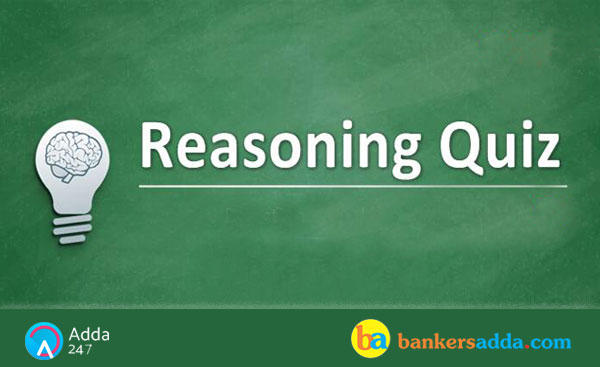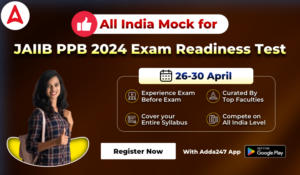Dear Aspirants,
Reasoning Ability is an onerous section. With the increasing complexity of questions, it becomes hard for one to give it a cold shoulder. The only way to make the grade in this particular section in the forthcoming SBI PO Prelims and other banking exams is to practice continuously with all your heart and soul. And, to let you practice with the best of latest pattern questions, here is the Adda247 Reasoning Quiz with the exact same pattern of questions that are being asked in the exams.
Following the study plan for SBI PO Preliminary Examination 2018, the third week starts with practice questions on Puzzles & Seating Arrangement and Syllogism. To ensure proper preparation of the section we advise you to go through all the questions sincerely and try to attempt each one of them. Afterward, match your solutions and the approach with the one that would be provided later. Practice more and more questions on the same section to enhance your grip over the topics. Following is the Reasoning Ability quiz to help you practice with the best of latest pattern questions.
Direction (1-5): Study the given information carefully to answer the given questions.
Ten persons are sitting in two parallel rows containing five persons each, in such a way that there is equal distance between adjacent persons. In row 1 — B, C, D, E and F are seated (not necessarily in the same order) and all of them are facing south. In row 2 — R, S, T, U and V are seated (not necessarily in the same order) and all of them are facing north. Therefore, in the given seating arrangement, each member seated in a row faces another member of the other row.
R sits second to the right of U. The person facing R sits to the immediate left of D. Only one person sits between D and E. E does not sit at an extreme end of the line. The person facing E is an immediate neighbour of T. S sits third to the left of T. F is not an immediate neighbour of D. B does not face U.
Q1. Who amongst the following facing V?
(a) F
(b) D
(c) C
(d) B
(e) E
Q2. Who amongst the following is facing C?
(a) T
(b) S
(c) V
(d) U
(e) R
Q3. What is the position of D with respect to F?
(a) Immediate left
(b) Second to the left
(c) Third to the right
(d) Immediate right
(e) Second to the right
Q4. Which of the following statements is true regarding B?
(a) None of the given statements is true
(b) C sits second to the right of B
(c) B sits at an extreme end of the row
(d) B faces one of the immediate neighbours of T
(e) Only two persons sit between B and F
Q5. Four of the following five are alike in a certain way based on the given arrangement and hence form a group. Which one of the following does not belong to that group?
(a) RU
(b) SR
(c) VT
(d) EB
(e) DC
Directions (6-10): In each question are given four statements followed by five conclusions, one of which definitely does not logically follow (or is not a possibility of occurrence) from the given statements. That conclusion is your answer.
(Note: You have to take the four given statements to be true even if they seem to be at variance with commonly known facts and then decide which of the given conclusions logically does not follow from the given statements disregarding commonly known facts.)
Q6. Statements:
Some chocolates are toffees.
Some chocolates are toffees.
All toffees are gems.
All gems are candies.
No candy is a stone.
Conclusions:
(a) No toffee is a stone.
(a) No toffee is a stone.
(b) Some chocolates are not stones.
(c) No gem is a stone.
(d) All stones being chocolates is a possibility.
(e) All gems being stones is a possibility.
Q7. Statements:
All letters are words.
All letters are words.
No vowel is a consonant.
Some words are papers.
All papers are vowels.
Conclusions:
(a) Some papers are consonants.
(a) Some papers are consonants.
(b) Some vowels not being papers is a possibility.
(c) All words being vowels is a possibility.
(d) No consonant is a vowel.
(e) No paper is a consonant.
Q8. Statements:
No table is a chair.
No table is a chair.
Some chairs are boxes.
No box is a cover.
All covers are drawers.
Conclusions:
(a) Some boxes are not tables.
(a) Some boxes are not tables.
(b) Some chairs are not covers.
(c) All chairs are covers.
(d) No cover is a box.
(e) Some drawers are covers.
Q9. Statements:
All cups are bottles.
All cups are bottles.
Some bottles are jugs.
No jug is a bucket.
All buckets are tubs.
Conclusions:
(a) Some jugs are bottles.
(a) Some jugs are bottles.
(b) Some cups are jugs is a possibility.
(c) Some bottles are not buckets.
(d) No cup is jug is a possibility.
(e) All tubs are jugs.
Q10. Statements:
All numbers are letters.
All numbers are letters.
No letter is a book.
Some books are papers.
No paper is a copy.
Conclusions:
(a) No number is a book.
(a) No number is a book.
(b) Some books are not copies.
(c) Some papers are not numbers.
(d) Some books are not letters.
(e) All papers being letters is a possibility.
Directions (11-15): Study the following information carefully to answer the given questions.
In a college canteen, there are eight friends for tea party. That eight friends are C, D, E, F, G, H, I and J are sitting in a straight bench with equal distances between each other, but not necessarily in the same order. Some of them are facing south and some of them are facing North.
J sits third to the right of G. D is an immediate neighbour of J and faces south. E sits second to the right of H. E is not an immediate neighbour of I. C sits at one of the extreme ends of the bench. Only three people sit between C and I. G sits exactly between C and I who faces south direction. Immediate neighbour of I face opposite directions to each other (i.e. if one neighbour faces North then the other neighbours faces south and Vice-Versa). C and F face the same direction as G (i.e. if G faces north then C and F also face North and Vice-Versa). Both the immediate neighbours of G face south.
Q11. Who sits between H and J?
(a) D
(b) I
(c) F
(d)C
(e) E
Q12. Who sits 2nd right of E?
(a) C
(b) D
(c) E
(d) F
(e) No one
Q13. How many friends are seated between E and D?
(a) Three
(b) Five
(c) Six
(d) Four
(e) No one
Q14. Who amongst the following sits third to the right of H?
(a) D
(b) I
(c) F
(d) C
(e) E
Q15. How many people face South as per the given arrangement?
(a) Three
(b) Five
(c) Six
(d) Four





 The Hindu Review October 2022: Download ...
The Hindu Review October 2022: Download ...
 SBI Clerk Previous Year Question Paper P...
SBI Clerk Previous Year Question Paper P...
 JAIIB PPB 2024 Exam Readiness Test: Regi...
JAIIB PPB 2024 Exam Readiness Test: Regi...



